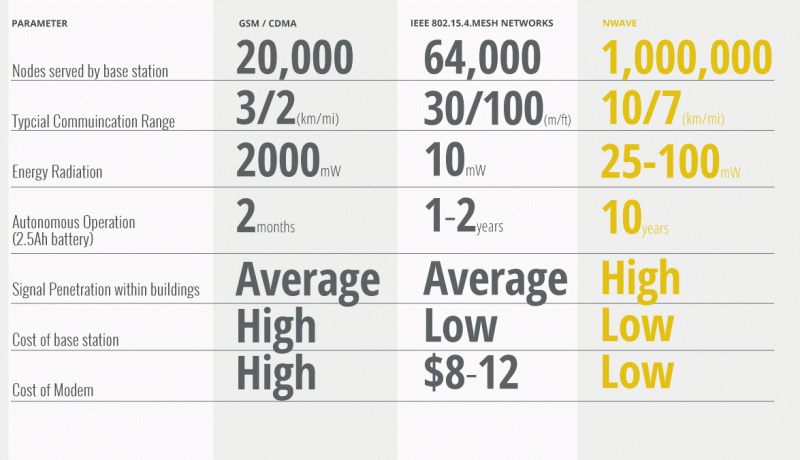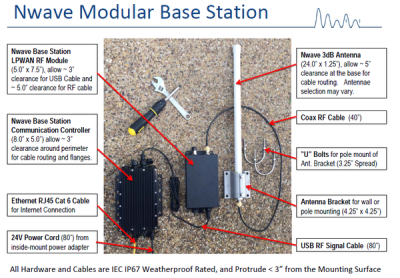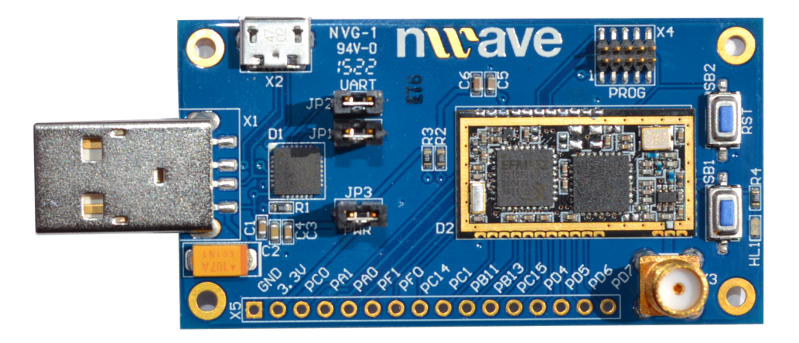It has been over 2 years since we last mentioned the Weightless SIG and their claims of an IoT open standard chip with a 10 year battery life and 10km wireless range, all at a jaw dropping price of $2 per chip. There was a planned production run of the 3rd gen chips which I would suspect went to beta testers or didn’t make it into production since we didn’t hear anything else, for years.
Recently, a company called nwave began producing dev-kits using the Weightless Technology which you can see in the banner image up top. Although the hardware exists it is a very small run and only available to members of the development team. If you happen to have been on the Weightless mailing list when the Weightless-N SDK was announced there was an offer to get a “free” development board to the first 100 development members. I use bunny ears on free because in order to become a member of the developer team you have to pay a yearly fee of £900. Don’t abrasively “pffffft” just yet, if you happened to be one first 100 there was an offer for developers that came up with a product and submitted it back for certification to get their £900 refunded to them. It’s not the best deal going, but the incentive to follow through with a product is an interesting take.
IoT Open Standard?
IoT projects tend to use WiFi, Bluetooth, Cellular, or ZigBee/DigiMesh but those last two are more often seen in industrial applications. Weightless is proposing an “IoT Open Standard” for wireless communication that takes advantage of the unlicensed sub-GHz band in combination with the now unused UHF spectrum (800 MHz to 900 MHz) we once used for terrestrial broadcast television. Weightless plans to use both of these frequency bands as a global communication protocol with base stations mounted to external structures around the globe. The Weightless SIG first started working on this technology in 2011 so they aren’t necessarily jumping on the IoT bandwagon, or not recently anyway.
Is There a Need For technology like Weightless?
The argument goes in both directions quite easily, after all WiFi (802.11) is cheap and readily available. The ability to add cheap WiFi to your project was recently popularized by the Espressif ESP8266 as well as the upcoming offering from Espressif, the ESP32. I’ve listened to very convincing arguments for WiFi as the IoT wireless standard, during which I was admittedly drinking the Kool-Aid pretty quickly. Maybe I’m easily swayed, but the argument is solid. WiFi is already everywhere.
I was in a shop a few months ago trying to connect to the business’ wireless network with my phone and I happened to see an SSID that was out of context “DART-533” it was called. My head whipped up from my phone, peered out the window and scanned the horizon for a bus, sure enough, at the stop light was “Dallas Area Rapid Transit #533” on the LED matrix scrolling message display in the window of the bus. How can you deny the availability of WiFi? The bus had an open network, you could collect sensor data all over Dallas in locations along the bus routes and be able to have each unit phone home multiple times a day/hour depending on the location. Obviously a WiFi enabled mass transit system is not the answer to the connectivity problem, my point is that open WiFi networks are all around us and remain to be a free resource.

Cellular is another solution that is becoming more and more available as service providers are opening up low transfer data plans to the public. Not so long ago adding a cellular modem and SIM card to your project would cost you another phone line on your existing plan, or you could hack a cheap burner with a prepaid plan. It turns out that what we wanted from the cell companies had existed all along, known as Machine To Machine (M2M) service. The problem being that the business model surrounding this service was very much still a face to face, hand-shaking, salesman setup. And if you weren’t buying enough service for someone to make a commission then you were pretty much out of luck. Those hand shakes were reserved for bank deployed ATM’s and Coca-Cola.
Weightless Sees a Gap in the Market
The chart shown above is from nwave, who are using the Weightless-N technology and you can see that there are some categories that are advantages to nwave/Weightless-N technology. The most impressive stats thus far are the range and battery life which you can see from the chart that they are unmatched. The other advantage Weightless has is the standard being open, so long as it is adopted by enough of the market.
Weightless-N Smart City networks

Weightless technology has been deployed in Denmark (Copenhagen and Esbjerg) as well as the UK (London and Cambridge) in the form of nwave base stations.
Although there are not any of the claimed $2 devices known on the market, the open standard Weightless-N uses unlicensed sub-GHz ISM band and the SDK is available royalty-free. Although it seems that the SDK is also only available to those who are paid members of the development team.
Weightless-P announced and ?
According to the press release on the Weightless site the new feature-rich Weightless-P standard is available. In comparison to the Weightless-N standard we have some improvements:
- fully acknowledged 2-way wireless link
- data rates up to 100kbps
- higher capacity network than existing LPWAN technologies
The press release also includes C-level company men saying things like “revolutionary” and “transform the space”. Which is worth about as much as an interview with an athlete who says “here for the team” and “we got out there and hustled”. The release does not say exactly what Weightless-P being “available” actually means, I suspect it would cost somewhere around £900 to find out.
Weightless-W MIA
The headlining feature of the Weightless technology is the use of the UHF band which was previously occupied by television transmission. The Weightless site has mention of it in a few places but no press releases, SDK, or 3rd party hardware. I think this is the piece of the puzzle that is most wanted and could really be a game changer. Understandably there is some bureaucracy involved in using this band of the spectrum for anything but we sure wish they would move it along so we can play! Sitting through the releases of Weightless-N and Weightless-P are making me restless and aggravated, like sitting on the edge of the pool during “adult swim” (the longest half hour of my childhood summer).
In Cyni-Summary
As cynical as I tend to be (maybe it has come across through the screen a bit?) this sounds like an interesting concept. I like to put my hands on hardware as much as the next guy and hearing about it for years without being able to see it at Mouser or Digikey is a bit like crying wolf. I understand the need for committed developers as initial hardware testers and the incentive program is a nice touch, but what’s the harm in selling your hardware to those who want to buy it just for the sake of selling hardware? I would buy a reasonably priced module just to play with, especially if I had access to a so-called Smart City Network.
So not much has really changed for the vast majority of us when it comes to Weightless technologies. Hopefully someday we’ll have some hardware of our own to play with. Until that happens you can watch this video a few hundred times.
















IoN …. Internet of Nothing
IowJSk – Internet of what John Snow knows.
Weightless is very real. Open standards take time to create and establish and Weightless is no exception. But Weightless-P, the culmination of a lot of effort from a very diverse consortium of global contributors is here. There are over 2000 global players in the Weightless ecosystem. We can discuss Wi-Fi, Ble, Zigbee, NB-IoT, LTE-MTE, 3GPP etc. but if you need a genuinely competitive LPWAN technology that delivers what is required for real smart city (et al) applications and use cases then you do need to embrace the idea that there are alternatives. Of these Weightless-P offers genuinely significant competitive advantages. If you want to engage – discuss, criticise, debate, whatever please do it here, or on the Weightless LinkedIn Group. Or better – get the LPWAN white paper on the Weightless website and see for yourself. You’ll also get access to a compelling hardware offer. Yep, hardware.
Neul and Nwave – they are independent companies. Weightless is a Standard.
Very good, very clever. Even though Weightless networks already exist on three continents.
What is Weightless? Is it a physical layer modulation scheme? How does it compare to Semtech’s LoRa (Low-power long-Range) which I already have on my desk?
https://www.cooking-hacks.com/documentation/tutorials/extreme-range-lora-sx1272-module-shield-arduino-raspberry-pi-intel-galileo
The fact that it’s sitting on your desk right now is what differentiates it from weightless.
in regards of me being lazy… i will not give you the shithead post prize of the year because that require me to check the years posts… remember me being lazy, so ofcource i mark you to be the shithead of the year
Not sure if wrong reply. I don’t see what makes you say that.
Still, I’m not lazy mate. What did you just say to me you little bro, I’ll have you know that I have over 300 confirmed development boards.
Not just physical, it seems they also do network and probably transport layer, but everything above that…? However, to be a useful “IoT standard”, they would need to go up to the application layer.
So it looks like they do competition to ZigBee modules and the ZigBee network, but don’t provide profiles like ZigBee Home Automation, meaning that device A from company A using that network is likely incompatible with device B made by company B.
“Standards” redefined…
That can come later. Or you could use somebody else’s profiles over their transport layer. That’s what’s good about the OSI model. Just one small company probably aren’t the right people to specify something like this. Wait til people start making things with it, or at least suggestions.
Wi-Fi is only MAC and PHY, even though it can be considered a useful “IoT standard”.
Weightless defines network and transport layer, and intentionally does not cover the application layer.
I would like to see a real mesh network with several hops running for more than 5 year in a real application with normal batteries.
LOL. There is literally no way that’s happening.
How do you wake up enough nodes at the same time to create a mesh? I mean just sending data some extra seconds is going to costs a lot of juice from that battery.
A synchronized protocol with time slots could be implemented, but I doubt it.
Store and forward. Was good enough for Fido / SMTP / Usenet for long enough. As long as the nodes eventually communicate. Just means results take longer to get back to base, not necessarily a problem.
For short range, low throughput, you have WirelessHART 2.4GHz. Synchronous, full mesh with TDMA. It can acheive long battery life, but obviously exhibits the drawbacks of mesh: some nodes drained much faster than others, difficult to troubleshoot, much reduced throughput, longer latency, and not scalable beyond a few dozen nodes (after which sub-networks are needed)
6LowPAN on one of those 10 year batteries that they put in smoke alarms?
I’ve been trying to get a dev kit from NEUL in Cambridge for years…they never gave me one although there was always talk about one being available soon…for about £10K!
I had worked with the founders of the company for a decade at CSR Plc but they were never willing to help an external company to make a product a reality :(
They are now owned by Huawei so its unlikely that the smaller guys can really get involved.
Hi Steven – we both know why that is.
I think I do, although your thoughts may be different, Alan!
:)
Nop – I reckon they are the same. We both know these people!
Neul/Huawei have pulled out of Weightless. Essentially Weightless-W is available for implementation in TV whitespaces, but availability/regulation make it complicated.
Targeted at sub-GHz ISM and license-exempt bands are -N and -P, the latter having been just published
Could you explain to the rest of the class what you think the reason might be? (I was very tangentially involved with Neul, too). Conspiracy or incompetence?
Pete – IMHO, it was a combination of several factors. Regulation of shared use of white space spectrum did not relax as quickly as initially anticipated leading to a significant commercial challenge to keep the VC funded Neul alive. There was poor commercial execution and weakness in the commercial team, with a less than coherent go-to-market strategy. And following a board level change seeing the appointment of a new CEO, a new direction, away from white space, and from licence exempt spectrum towards what was then loosely LTE-M (therefore away from Weightless). This model was never going to deliver near term ROI and VCs really like near term ROI – right there is an issue. A search for strategic investors took Neul very close to running out of money which is not a good place from which to negotiate new investment. That Huawei paid 25m for a company that had had 18m invested in it demonstrates that very little premium had been generated over four years of effort. Huawei have an interesting proposition – it might be successful.
In the meantime Weightless responded to the the widespread unavailability white space spectrum access by focusing on ISM spectrum. Initially with Nwave with a low cost unidirectional standard, Weightless-N and now with an ultra high performance LPWAN standard, Weightless-P. This latter technology repurposes a significant amount of the IP developed for the original standard and is championed by a well funded, well managed, technically competent professional team at M2COMM. As noted elsewhere in these comments, hardware is everything. Later this month we will be working with M2COMM to offer hardware on a pre-order basis – expected end Q1 – combined with a very special offer, including free membership. It will be unlike any other LPWAN tech. Detailed technical information is available on the Weightless website; download the white paper for more.
For the record, the Weightless SIG is an independent, global, members based, non-profit, standards organisation. It was never ‘owned’ by Neul, or any other vendor, and remains independent today (and tomorrow…). It is an organisation like the Bluetooth SIG – operated for the benefit of its members.
Yeah, all of these companies are frauds and failures. the Iot wonderchip is the esp8266 people have already got them doing meshes and other neat tricks and they already have the price point. AND guys already have them running for a year on 2 AA batteries.
That’s interesting. Looks very similar to waviot in the US.
You’ll be surprised, but Waviot is us also =) check strij.net vs waviot.com product line. Though waviot is more like a probe rather then real active operation.
Makes sense. Kinda sucks that ON bought AXSEM and jacked up all the prices?
whoa, that’s awesome! for someone who isn’t allowed to say a lot, that sure is a lot of information ;)
were the power specifications as good as advertised?
If you mean RF power, then we are mostly constrained by regulations. In USA we can do 26dbm, but such mode is far to power-hungry. If you mean supply power, then it’s the most common 3.3V, about 50ma @14dbm or 300ma at 28dbm
While LoRa is more available and seems to work really well (check out Dave Akerman’s balloon-balloon LoRa comms http://www.daveakerman.com/?p=1850) there is a lot of unknown magic that seems to go one inside the chips.
We’ve been working on a simple low powered mesh-like network called UKHASnet (http://ukhas.net) using FSK on 869.500Mhz – we’ve used it on ground nodes, balloons, sea buoys (floating mesh network), quadcopters. We have gone for the simpler cheaper setup rather than LoRa to remain open and its allowed us to use both RFM69HW radio modules but also develop a software decoder and use other RF chips. It does mean that we miss out on the extra range that something like LoRa would provide but has allowed us not to be reliant on a single proprietary system. While we’ve had modules running on 3 AAs for over a year thats only in a beacon mode, repeater nodes need some sort of power source such as solar to keep on running.
For more info check out http://ukhas.net or on irc.freenode #ukhasnet
I don’t think 100mw at 800mhz can travel 10km … Maybe if it’s a tuned directional antenna and an active receiver …
25mw with simple whip can travel even longer, 50 line-of-site easily. For that you need a good reception antenna (like 13dbi sector), good low noise high sensitivity receiver (-145dbm with 100baud modulation and 1/3 error correction coding). Of course antennas should be matched as fine as possible, oscillators chosen for enough frequency stability etc., but practically it is absolutely doable.
Yes, you can get -145dBm of noise floor in an anechoic chamber